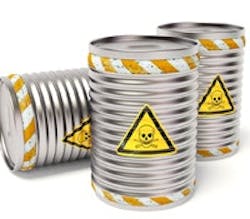U.S. and Europe Target Chemical Munitions Disposal
The current approach for identifying and destroying buried chemical munitions and related chemical warfare materials (CWM) uncovered during environmental remediation projects is neither reliable enough, nor has the capability to efficiently tackle large-scale projects, warns a new report from the National Research Council (NRC), Washington, D.C.
[pullquote]
In "Remediation of Buried Chemical Warfare Materiel," the NRC calls for an alternative or modified approach to remediate the Redstone Arsenal, Huntsville, Ala., and other such projects on active and former U.S. Department of Defense (DOD) sites and ranges.
Following a 1985 directive from Congress, the Army was tasked with destroying the existing U.S. stockpile of chemical weapons. To date, 90% of the stockpile has been destroyed, and the remaining 10% is expected to be destroyed by 2022.
However, during the early- to mid-20th century, disposal of chemical weapons and CWM often comprised open-pit burning and burial at approximately 250 sites in 40 states, the District of Columbia, and three territories. Remediation of this buried material, in addition to environmental cleanup of the burial sites, poses significant challenges to the nation and DOD. The report examines important regulatory issues that ultimately affect the need, timing and costs of remediation at these sites.
To destroy any intact chemical munitions uncovered during remediation efforts, teams will most likely use either the Army's Explosive Destruction System (EDS) or one of three commercially available technologies. The EDS is an effective and reliable technology, and the Army has an active R&D program under way to improve the throughput rate, or speed, at which chemicals can be treated.
The three commercially available destruction technologies boast higher throughput rates, but reliability problems were encountered when one of these — the Dynasafe Static Detonation Chamber — was used to destroy a portion of stockpiled munitions in Anniston, Ala. The report recommends ways to alleviate these problems and suggests alternatives to the EDS and commercial systems. It also explores the potential use of robotic systems to access and remove buried CWM.
However, the lack of accurate inventory of buried munitions and reliable cost estimates for the remediation (RCWM) program hampers establishing precise, long-term budget requirements and drawing up a funding plan.
The report recommends as a "matter of urgency" that the secretary of defense increase funding for the remediation of CWM to enable the Army to complete the inventories of known and suspected buried chemical munitions no later than 2013 and develop a quantitative basis for overall funding of the program.
Meanwhile, the Finnish Environment Institute (SYKE), Helsinki, Finland, is involved in an international four-year, €4.5 million ($6 million) European Union funded project, known as CHEMSEA (Chemical Munitions — Search and Assessment), to assess the effect of World War II dumping sites of chemical munitions in the Baltic Sea. It uses the blue mussel to assess exposure of the marine species to chemical warfare agents, along with how life in the Baltic is affected.
Approximately 50,000 metric tons of chemical munitions were dumped in the Baltic Sea after World War II, most of them containing poisonous chemicals. The most well-known dumping sites are the Bornholm and the Gotland Deep and the Little Belt strait in Denmark. Chemical munitions also were jettisoned in the strait of Skagerrak, between Denmark and Norway. Details here are sketchy, but there could be up to 117,000 mt of materiel there. For now, there's no exact information on other possible dumping sites, but unofficial information suggests that dumping also took place in the Gdansk Deep.
In the study, the mussels were kept in cages at four sites, at two depths (35 and 65 meters), for just over two months. The cages were retrieved in mid-August. In the laboratory, the mussels currently are undergoing chemical analyses and measurements of various biological markers to determine whether they have been exposed to the chemicals in question, along with the potential biological effects of such exposure. SYKE expects to publish its initial results in early 2013.
SEÁN OTTEWELL is Chemical Processing's Editor at Large. You can e-mail him at [email protected].
